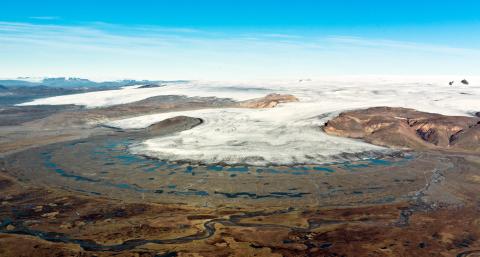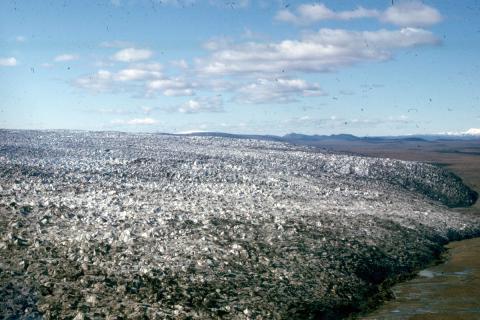Glaciers
Glaciers cover around 11% of Iceland. The biggest of these are the ice caps found in central and southern Iceland. The largest of them all is Vatnajökull, with an area of around 7,900 km2 and an approximate volume of 3,000 km3. Vatnajökull is often described as Europe’s largest glacier, although the Severny Island ice cap in the Novaya Zemlya archipelago in northern Russia is bigger.
Other large ice caps are Langjökull (900 km2), Hofsjökull (890 km2) and Mýrdalsjökull (560 km2). Iceland’s fifth-largest glacier is Drangajökull (142 km2) in the Westfjords.
Glaciers form Earth’s largest reservoir of fresh water. Iceland’s glaciers store around twenty times the country’s average annual precipitation. Were they to melt, the water would cause the global sea level to rise around 1 cm. Glaciers are the source for all major rivers in Iceland. Meltwater from glaciers accounts for around a third of the water that flows into the ocean annually in Iceland.

Glaciers can be classified in different ways, including on the basis of their size, shape, position in the terrain, and thermal state (heat budget).
Shape and position in the terrain
Ice caps
Ice caps form on table mountains or plateaus. In some places, where many local glaciers have grown together due to lowering of the glaciation line during cold periods over the last 4–5 thousand years, ice caps cover a wide area. This is true of the very largest glaciers in the Central Highlands, the Westfjords, and the southern part of Iceland. Smaller ice caps can be found in the vicinity of much larger ones, covering only a single mountain peak or plateau. Two examples are Eiríksjökull, an ice cap near Langjökull, and Þrándarjökull, which is located southeast of Vatnajökull.
All ice caps in Iceland have retreated and thinned considerably from the close of the Little Ice Age at the end of the nineteenth century. Since 1995, the pace of glacial retreat has been very rapid due to the warming climate, which is unfavourable for glaciers.
Cirque and valley glaciers
In mountainous areas of Iceland and in the vicinity of the large ice caps, one finds numerous smaller glaciers, known as cirque glaciers and valley glaciers. These glaciers are situated in cirques (bowl-shaped hollows) and valleys – generally deep formations dug into the terrain by water and glacial erosion in ancient times. Steep slopes and cliffs enclose cirque and valley bottoms, providing shade and shelter from wind. This, and snow accumulation due to the effects of the terrain, enables glaciers to form within these depressions.
Most glaciers in Iceland are situated on the Tröllaskagi peninsula. They total around 150, nearly all of which are cirque and valley glaciers. There are over 20 such glaciers on the Flateyjarskagi peninsula, and several in the Eastfjords and the northern part of the Westfjords. There are signs that small glaciers proliferated in the chillier climate of cold periods during the later Holocene, for example the Little Ice Age.
Many small glaciers are partially or completely covered by scree, which falls from the cliff-sides above the glaciers. This layer of scree has an isolating effect, protecting the glacier ice from warm weather and solar radiation.
There are indications that sheltered cirque and valley glaciers in mountainous regions of Iceland may actually outlast the ice caps in a warming climate, particularly where scree covers all or part of the glacier’s surface. Some small glaciers have nevertheless vanished since the beginning of the twentieth century due to climate warming, for example Ok west of the Langjökull ice cap and Lambadalsskarðsfönn in Álftafjörður, where the remains of the glacier are manifested as perennial snowfields in fresh moraines.

Glacial thermal regime
Glaciers are sometimes classified on the basis of their thermal regime as either temperate or polar.
Temperate glaciers
Icelandic glaciers are temperate as a rule. Temperate glaciers (or warm-based glaciers) are those where the ice remains at a temperature of around 0°C throughout. Since the glacial ice is around its melting temperature, there is always water in a liquid state and under the glacier, facilitating deformation of the ice and ice-flow from accumulation zones down to ablation zones. Temperate glaciers are most common in fairly mild climates where many metres of snow cover the glacier’s surface in winter, including Iceland, Norway, and some parts of Alaska.
Polar glaciers
Polar glaciers (or cold-based glaciers) remain well below the freezing point at all times of year. This type of glaciers is common in Arctic and Antarctic regions. Ice deforms and flows much more slowly than on temperate glaciers, and polar glaciers are also frozen to their substrates. None of Iceland’s glaciers are known to be polar glaciers. However, they are indications that the glacial termini on the north side of the Vatnajökull ice cap are frozen to their substrate between glacial surges.
Glacier mass balance and movement
The snow line is a non-static boundary that divides a glacier into two main zones. Above the snow line is the accumulation zone, where more snow has accumulated over the year than has melted away in summer. Below the snow line is the ablation zone, where all the winter snow has melted, and often a part of the glacier ice as well. On Iceland’s ice caps, accumulation zones are often glacial plateaus of sorts over 1,000–1,300 metres above sea level.
The mass balance of a glacier is the difference between accumulation above the snow line and ablation below the snow line. The mass balance can be positive (more accumulation than ablation), negative (more ablation than accumulation), or in equilibrium. If accumulation is greater, then the glacier will grow in volume and will advance and increase in area. If ablation is greater, then the glacier will retreat and grow thinner. Smaller glaciers, such as cirque and valley glaciers, respond quickly to changes in mass balance. Larger glaciers, such at Vatnajökull ice cap, generally react more gradually over a period of several years to changes in mass balance.
Glaciers are divided into two categories on the basis of how they move and how they transport winter accumulation to ablation zones. Non-surge-type glaciers are quick to respond to the climate and the resulting changes in glacial mass balance. Surge-type glaciers, on the other hand, retreat gradually for long periods but then surge rapidly forward over a period of months or years without these surging events being directly correlated to the current climatic conditions.
Non-surge-type glaciers
Non-surge-type glaciers respond almost immediately to climate change (i.e., changes in glacial mass balance). They retreat and become thinner when the mass balance is negative and grow when the mass balance is positive. Ice-flow on non-surge-type glaciers is constant, transporting snow and ice from accumulation zones immediately rather than permitting them to build up in these areas. Outlet glaciers extend from the ice caps, often transporting glacial ice far below the snow line, where it eventually melts.
Surge-type glaciers
Surge-type glaciers do not respond immediately to climate change and changes in glacial mass balance, unlike non-surge-type glaciers. Instead, they gradually retreat for decades, while snow and ice accumulates on their upper reaches. These periods are known as quiescent phases. During these long quiescent phases, the accumulating ice and snow cause the upper part of the glacier to thicken and its surface to rise. At the same time, the lower reaches are thinning due to ablation. The ice-surface slope slowly increases until a certain threshold is passed. The steepening glacier can no longer support the accumulated ice in the upper reaches and surges forward. The surge, which lasts only a few months to a few years, advances the glacier by anywhere from hundreds of metres to several kilometres. The event is not triggered by the climate or weather events at the time of the surge’s onset, but rather by the mass of snow and ice that has built up in the glacier’s accumulation zone.
Brúarjökull, an outlet glacier of Vatnajökull ice cap, is one of Iceland’s largest surge-type glaciers. Brúarjökull’s surges are spectacular, as the ice margin advances several kilometres within the space of only a few months, moving over 100 metres per day at its fastest, at intervals of around 70–90 years. Some of the world’s smallest surge-type glaciers are found on the Tröllaskagi peninsula: Búrfellsjökull, Teigarjökull and Vífilsjökull. Their surges are much slower, lasting several years and occurring at intervals of 45–60 years.
